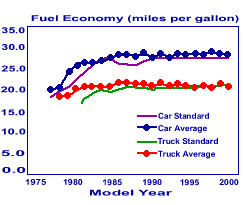

|
|
DOT ProgramsAutomotive Fuel Economy ProgramIntroductionIn 1975, the U.S. Congress, responding to dramatic increases in petroleum prices, set minimum average standards for automobile fuel economy- the amount of fuel consumed by a vehicle per mile of travel. These standards were established under the Energy Policy and Conservation Act (EPCA) of 1975, and have subsequently been both increased and expanded to cover most light trucks. Different standards are in place for automobiles and light trucks. The Corporate Average Fuel Economy (CAFE) program was established to determine vehicle manufacturers' compliance with these standards. Relationship to Climate ChangeMost automobiles and light trucks are currently fueled with petroleum-based gasoline and diesel fuel. Carbon accounts for most of the mass of these fuels. When fuel is burned, as in an automobile engine, virtually all of the carbon in the fuel is released to the atmosphere as carbon dioxide, a key greenhouse gas. The CAFE program provides vehicle manufacturers with one incentive to sell more fuel-efficient vehicles automobiles and light trucks. There is considerable debate regarding CAFE's influence relative to, for example, fuel prices and consumer preferences, and regarding the broad impacts of CAFE. However, the figure below shows that new cars and light trucks are, on average, very close to the current standards, which suggests that they would consume more fuel without this program.  DOT's RoleThe Secretary of Transportation is required to administer a program for regulating the fuel economy of new passenger cars and light trucks in the United States market. The authority to administer the program has been delegated by the Secretary to the Administrator of NHTSA. NHTSA's responsibilities in the fuel economy area include:
Passenger car fuel economy standards were established by Congress for Model Year (MY) 1985 and thereafter at a level of 27.5 miles per gallon (mpg). NHTSA is authorized to amend the standard above or below that level. The agency has established light truck standards each year, but Congress has mandated through the DOT Appropriations Acts for fiscal years 1996 through 2000, no increase from the MY 1996 value of 20.7 mpg for MYs 1998 through 2002. DOT shares responsibility for the CAFE program with the U.S. Environmental Protection Agency (EPA), which administers the testing program that generates the fuel economy data and determines the procedures for calculating the fuel economy values for CAFE. Additional InformationDOT's Twenty-third Annual Report to Congress on the Automotive Fuel Economy Program Information on fuel economy testing Fuel Economy A web site cosponsored by the U.S. Department of Energy and the U.S. Environmental Protection Agency to help the public factor energy efficiency into their car buying decisions.
|